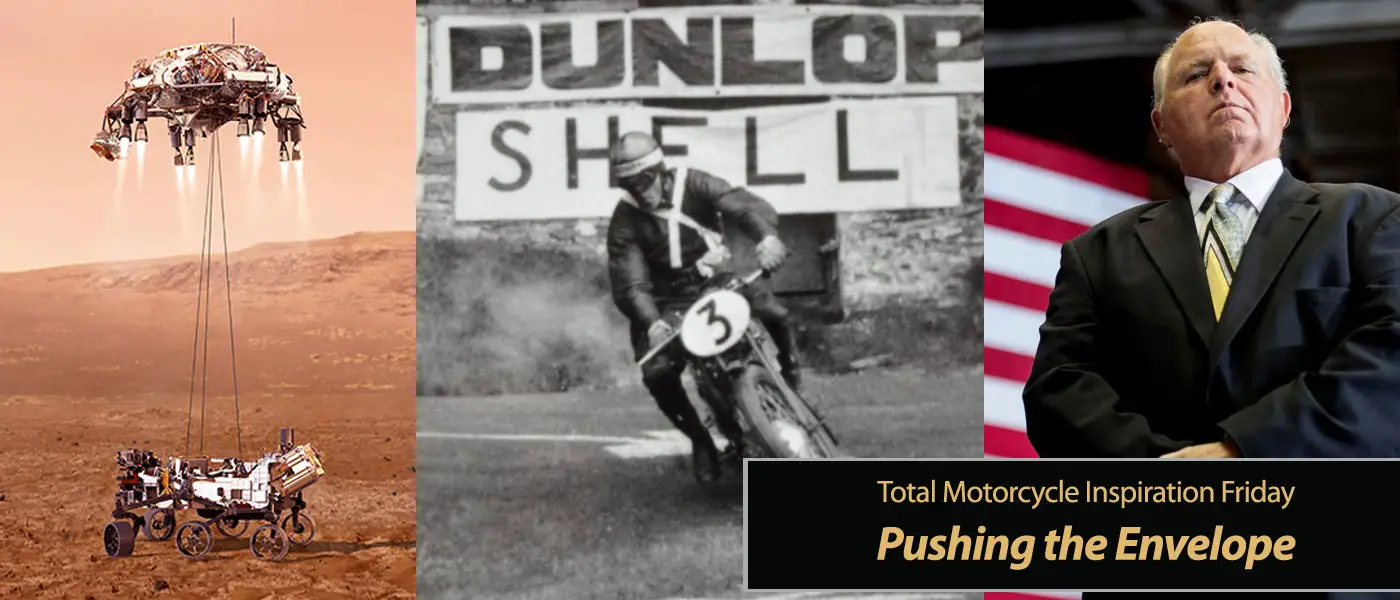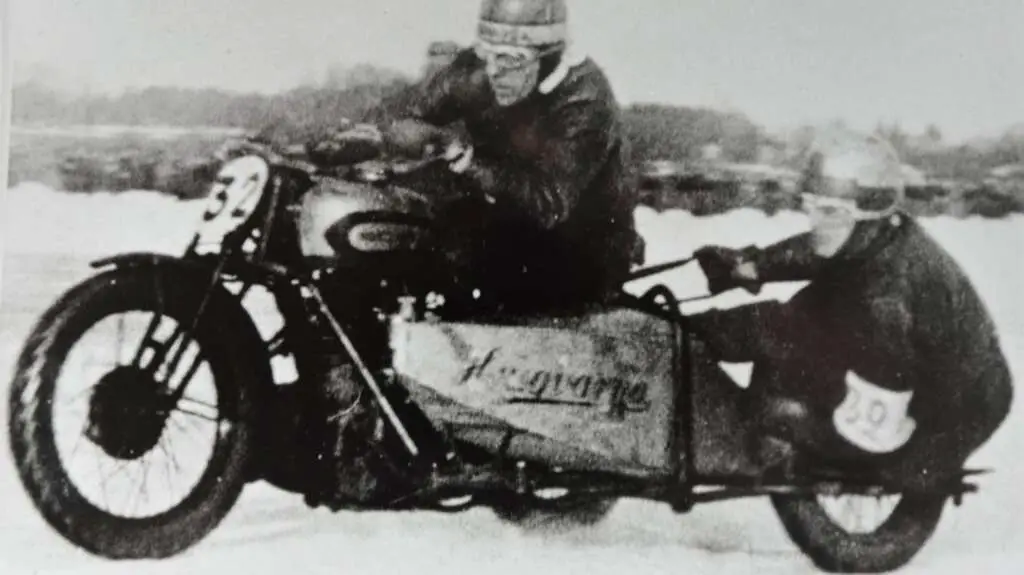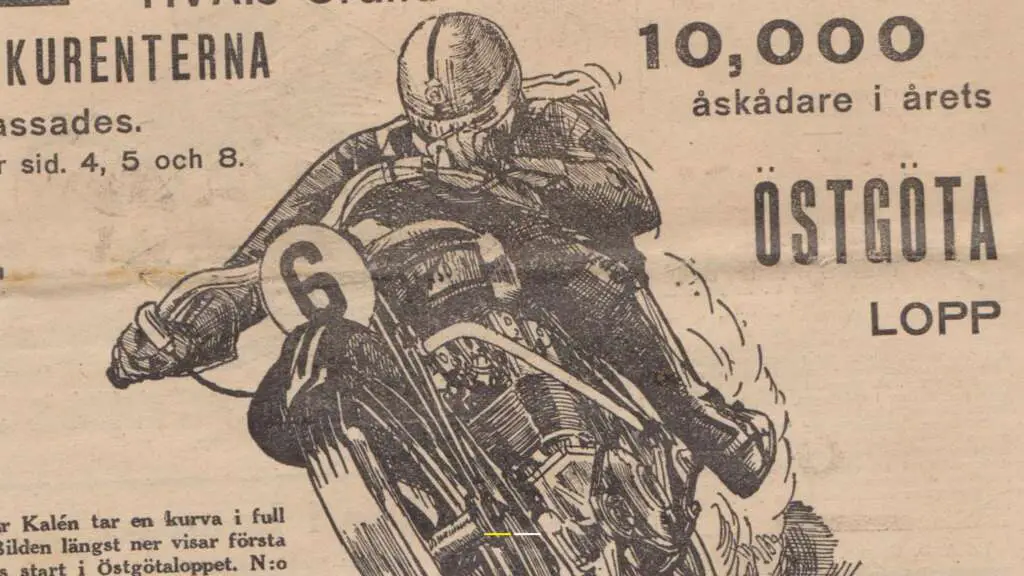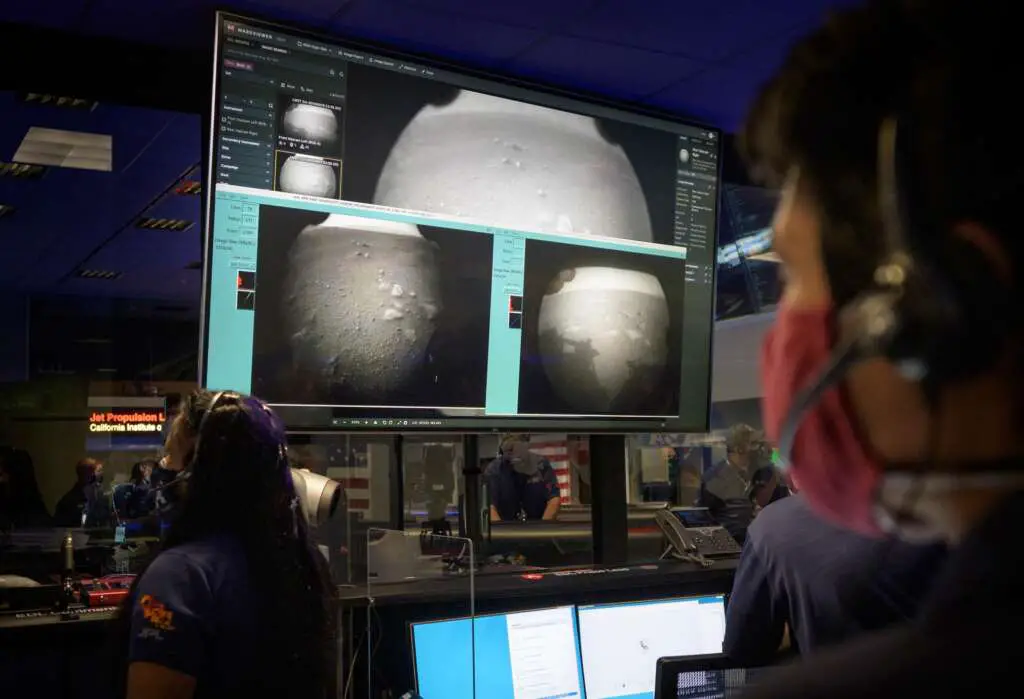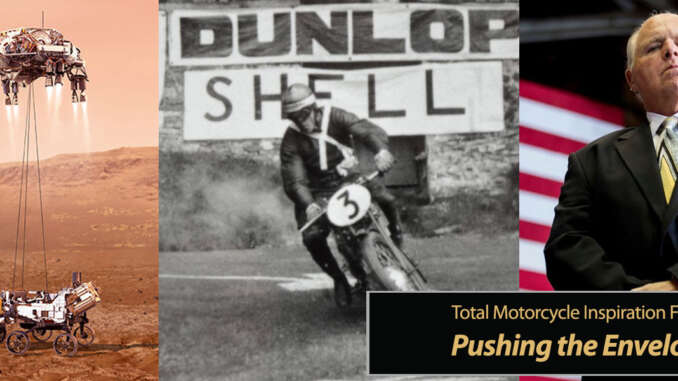
Today’s Inspiration Friday: Pushing the Envelope is all about striving to be the best, going up against the odds and succeeding in the face of adversity. NASA Perseverance Mars Lander reached for the stars, Rush Limbaugh reached for radio legacy and 91 years ago Husqvarna racer Gunnar Kalen reached to be second to none on the 1930s race tracks. Even though sweden lost one of their most successful riders ever, Kalén died with a smile on his face doing what he loved and making a difference. You can make a difference too be it in exploring, being a voice for what you believe in or riding for your Countries flag. Don’t just dream it, DO IT, push that envelope.
Total Motorcycle would like to thank Husqvarna, NASA and The Rush Limbaugh Show for inspiring us to bring you this week’s Inspiration Friday: Pushing the Envelope. Each week we bring you another Inspiring Motorcycle story to inspire you to get out and ride! Thank you for your support for visiting us and supporting us at Patreon for just $1 a month.
With that said, let me tell you the story of Gunnar Kalen…
Gunnar Kalen, the quiet man with immense talent and speed
Swede Gunnar Kalen was contracted to Husqvarna in 1930. The quiet man from Bettna, Sweden did most of his talking on the racetrack where he was almost unbeatable. His success story lasted for five years before tragedy struck in 1934. The brilliant Kalén was as fast on ice as he was on the track – his wins and records were second to none during the peak of his career.
The night sky on December 4, 1927 was crisp and clear – there were sparkles from the snow in the freezing cold weather. On the calendar the date was marked in red, which meant it was Sunday. A new day on the track for Gunnar Kalen on a lake in the vicinity of Hedemora, a town in the district of Dalarna. The previous day, Gunnar had been driving north from the southernmost city of Malmö – a distance of around 850 kilometres, in order to make the start on this chilly day.
Straddling his 500cc Saroléa, Gunnar had to compete with a well-known rider who was riding a big twin-cylinder Husqvarna 750cc. The 750-man shot away from the start but soon Kalén was up behind his faster rival.
He stood no chance against the more powerful bike – until the corners approached. People had heard of Australian riders who were broadsiding in dirt track racing, but no one had so far witnessed a rider who performed this trick on ice – until now. Kalén came full throttle into the bend and simply put his foot down to balance the act through the corner. His opponents never stood a chance of catching up. Kalén won the race in grand style!
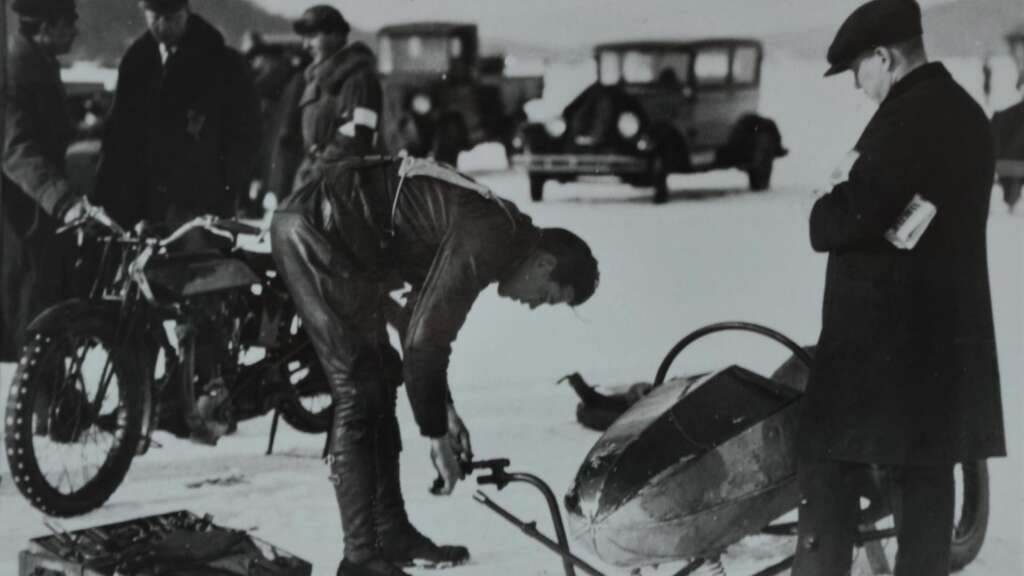
Gunnar Kalen was born on the 17th of September 1901 and rode his first race on August 10th, 1923. He rode a Reading Standard and in his debut he came third over the finish line. The Swede, born in Bettna in mid-Sweden, was a handsome, muscular man whose tongue never slipped without having something meaningful to say. He was as quiet in the paddock as he was relaxed during his performances. Kalén was a keen rider who often gave good advice to younger talents to make them improve and go faster.
“Gunnar was an ideal sportsman,” said employer Axel Löfström about his factory rider during 1927-30. Some of Kalén’s greatest successes were his five wins in the classic Novemberkasan between 1926-30. His sixth win would then have followed in 1933 when Gunnar rode his factory Husqvarna. At the start there were 13, of which 11 retired – either by machine trouble or out of exhaustion.

In 1929 Gunnar Kalen won most of his races all over the country. When he looked back on his triumphant season Gunnar had 19 victories and came home second not less than 10 times. All achievements were attained on his Belgian Saroléa machine. But in 1930 that was no more. Husqvarna had noticed this privileged rider and offered Kalén a factory contract, which he accepted. His skill connected perfectly with the vast experience of team manager Folke Mannerstedt, who helped develop competition machines that were of premium quality – and they were fast!
In the beginning of 1931, the SuperSwede set an amazing record on ice in Norway. The event was held on Lake Gjer south of Oslo where Kalén entered both as a solo, and sidecar rider. In the solo class he beat the old ice record doing 142.5 km/h on his 1,140cc Husqvarna. When he did 116 km/h on the sidecar machine, people started to wonder whether their clocks were accurate or not.
“I think it will be possible to do 150 km/h on my sidecar,” commented Kalén after his tremendous success.
This statement became reality later in the year when Kalén set a sidecar record that stood for 20 years, before it was beaten.
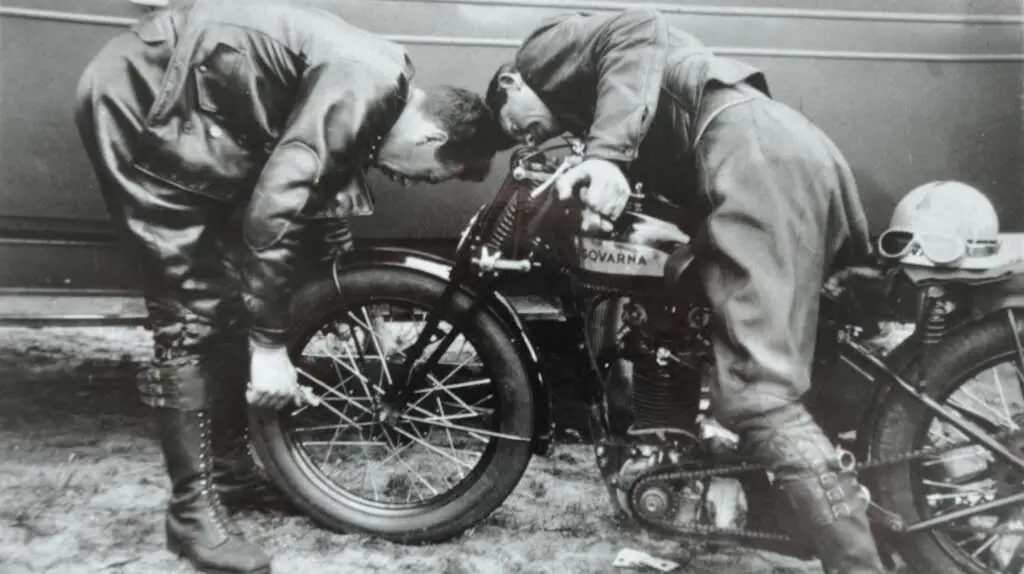
The Saxtorp Grand Prix of Sweden was held for the third time back in 1932, when Kalén started his victorious career on this world-famous track. Husqvarna had developed two new 500cc machines, which were put into the hands of Kalén and the 24-year old newcomer Ragnar Sunnqvist. After three and a half hours of racing, Sunnqvist beat Kalén with a margin of six minutes. Husqvarna had a double victory on their home turf.
The following year Saxtorp was upgraded and had the status of the European Grand Prix. People came to watch from every corner of the continent. 57 riders from 10 countries competed and the crowd was estimated to be around 150,000 spectators.
Husqvarna had done their homework with updated machines. To the eye you could only tell that the tanks had been revised and now had a capacity of 25 litres each. It was inside the engines however that most of the factory work had been performed by Mannerstedt & Co.
It seemed that Kalén was out of luck as he had to change spark plugs after only a few kilometres. Everyone counted him out of a top position. After 20 of the 30 laps the Norton of the British leader broke down, then on the very last lap Sunnqvist lost his chain, which eliminated him from the race. Gunnar Kalen had, step-by-step, caught up with the leaders and now seemed to have a free path to the finish line. He crossed it first and was crowned European Champion in 1933.
Did Gunnar Kalen become a rich man during his years at Husqvarna? “No,” said Folke Mannerstedt. “Gunnar Kalen had normal wages as a factory employee, but he had some profit from the prize money he received at each big event.”
1934 was to be the big year for Husqvarna. Unfortunately, they were not victorious. The season started with an accident at the harbour when the machines were loaded onto a ship, on their way to the Isle of Man. All the Huskies were severely damaged and had to be brought back to Husqvarna for repairs. Eventually, Kalén made the race, but was unsuccessful as he had to stop numerous times in order to change plugs on the foggy island. In the end, he ran out of spark plugs and retired.
Things did not improve at the next GP in Holland. Kalén had a spill and bent his front forks badly, which forced him to retire once again.

The third race was held at the famous Hohenstein-Ernstthal circuit in Germany. The track was 8.7 kilometres long, winding along some beautiful landscape. However, the surroundings were filled with big trees and other treacherous obstacles. During the first practice session, a German rider lost his life when he went off the track, hitting a tree.
After further training sessions, the track was once again criticized by both riders and managers. Josef Klein, one of Germany’s best riders, was also killed hitting a tree while his countryman Bauhofer had severe back injuries after a big crash. Ragnar Sunnqvist was hit likewise, he went off the track and suffered concussion as well as pain in his wrist. “I think our old frames would have been better suited to this track,” Kalén remarked, as he was jumping back and forth with his new, and shorter, factory frame that was less stable than the longer ones used before.
Shortly after one o’clock the German flag was waved and the starters were off outside Chemnitz. Kalén was lying third with Sunnqvist leading followed by a British rider. “After some time, the two of them came storming past me and I remember thinking, this cannot go well,” said Sunnqvist after the race. In a hole going through a lefthander at Badkobe, Kalén lost grip and went off the track into the woods where he met his destiny.
“Everything happened so fast,” said Sunnqvist afterwards, “it was difficult to establish what really went on.” Kalén had lost his life when he hit his head. He died immediately. “When I passed the crash site on the next lap, Gunnar still lay in the same place and I realized that something dreadful had occurred,” Sunnqvist told with sad eyes. After 25 laps Sunnqvist was ordered into the pits to refuel his machine.
“I could see by the tragic looks in the paddock that Gunnar Kalen was no longer among us.”
The 1st of July in 1934 became a sorrowful day and Sweden lost one of their most successful riders ever. Kalén died with a smile on his face. Everyone missed his keen eyes, his calm manners and his firm grip when saying hello. Gunnar Kalen won most of his races during a brilliant career that lasted for 11 years.
Touchdown! NASA’s Mars Perseverance Rover Safely Lands on Red Planet
The largest, most advanced rover NASA has sent to another world touched down on Mars Thursday, after a 203-day journey traversing 293 million miles (472 million kilometers). Confirmation of the successful touchdown was announced in mission control at NASA’s Jet Propulsion Laboratory in Southern California at 3:55 p.m. EST (12:55 p.m. PST).
Packed with groundbreaking technology, the Mars 2020 mission launched July 30, 2020, from Cape Canaveral Space Force Station in Florida. The Perseverance rover mission marks an ambitious first step in the effort to collect Mars samples and return them to Earth.
“This landing is one of those pivotal moments for NASA, the United States, and space exploration globally – when we know we are on the cusp of discovery and sharpening our pencils, so to speak, to rewrite the textbooks,” said acting NASA Administrator Steve Jurczyk. “The Mars 2020 Perseverance mission embodies our nation’s spirit of persevering even in the most challenging of situations, inspiring, and advancing science and exploration. The mission itself personifies the human ideal of persevering toward the future and will help us prepare for human exploration of the Red Planet.”
About the size of a car, the 2,263-pound (1,026-kilogram) robotic geologist and astrobiologist will undergo several weeks of testing before it begins its two-year science investigation of Mars’ Jezero Crater. While the rover will investigate the rock and sediment of Jezero’s ancient lakebed and river delta to characterize the region’s geology and past climate, a fundamental part of its mission is astrobiology, including the search for signs of ancient microbial life. To that end, the Mars Sample Return campaign, being planned by NASA and ESA (European Space Agency), will allow scientists on Earth to study samples collected by Perseverance to search for definitive signs of past life using instruments too large and complex to send to the Red Planet.
“Because of today’s exciting events, the first pristine samples from carefully documented locations on another planet are another step closer to being returned to Earth,” said Thomas Zurbuchen, associate administrator for science at NASA. “Perseverance is the first step in bringing back rock and regolith from Mars. We don’t know what these pristine samples from Mars will tell us. But what they could tell us is monumental – including that life might have once existed beyond Earth.”
Some 28 miles (45 kilometers) wide, Jezero Crater sits on the western edge of Isidis Planitia, a giant impact basin just north of the Martian equator. Scientists have determined that 3.5 billion years ago the crater had its own river delta and was filled with water.
The power system that provides electricity and heat for Perseverance through its exploration of Jezero Crater is a Multi-Mission Radioisotope Thermoelectric Generator, or MMRTG. The U.S. Department of Energy (DOE) provided it to NASA through an ongoing partnership to develop power systems for civil space applications.
Equipped with seven primary science instruments, the most cameras ever sent to Mars, and its exquisitely complex sample caching system – the first of its kind sent into space – Perseverance will scour the Jezero region for fossilized remains of ancient microscopic Martian life, taking samples along the way.
“Perseverance is the most sophisticated robotic geologist ever made, but verifying that microscopic life once existed carries an enormous burden of proof,” said Lori Glaze, director of NASA’s Planetary Science Division. “While we’ll learn a lot with the great instruments we have aboard the rover, it may very well require the far more capable laboratories and instruments back here on Earth to tell us whether our samples carry evidence that Mars once harbored life.”
Paving the Way for Human Missions
“Landing on Mars is always an incredibly difficult task and we are proud to continue building on our past success,” said JPL Director Michael Watkins. “But, while Perseverance advances that success, this rover is also blazing its own path and daring new challenges in the surface mission. We built the rover not just to land but to find and collect the best scientific samples for return to Earth, and its incredibly complex sampling system and autonomy not only enable that mission, they set the stage for future robotic and crewed missions.”
The Mars Entry, Descent, and Landing Instrumentation 2 (MEDLI2) sensor suite collected data about Mars’ atmosphere during entry, and the Terrain-Relative Navigation system autonomously guided the spacecraft during final descent. The data from both are expected to help future human missions land on other worlds more safely and with larger payloads.
On the surface of Mars, Perseverance’s science instruments will have an opportunity to scientifically shine. Mastcam-Z is a pair of zoomable science cameras on Perseverance’s remote sensing mast, or head, that creates high-resolution, color 3D panoramas of the Martian landscape. Also located on the mast, the SuperCam uses a pulsed laser to study the chemistry of rocks and sediment and has its own microphone to help scientists better understand the property of the rocks, including their hardness.
Located on a turret at the end of the rover’s robotic arm, the Planetary Instrument for X-ray Lithochemistry (PIXL) and the Scanning Habitable Environments with Raman & Luminescence for Organics & Chemicals (SHERLOC) instruments will work together to collect data on Mars’ geology close-up. PIXL will use an X-ray beam and suite of sensors to delve into a rock’s elemental chemistry. SHERLOC’s ultraviolet laser and spectrometer, along with its Wide Angle Topographic Sensor for Operations and eNgineering (WATSON) imager, will study rock surfaces, mapping out the presence of certain minerals and organic molecules, which are the carbon-based building blocks of life on Earth.
The rover chassis is home to three science instruments, as well. The Radar Imager for Mars’ Subsurface Experiment (RIMFAX) is the first ground-penetrating radar on the surface of Mars and will be used to determine how different layers of the Martian surface formed over time. The data could help pave the way for future sensors that hunt for subsurface water ice deposits.
Also with an eye on future Red Planet explorations, the Mars Oxygen In-Situ Resource Utilization Experiment (MOXIE) technology demonstration will attempt to manufacture oxygen out of thin air – the Red Planet’s tenuous and mostly carbon dioxide atmosphere. The rover’s Mars Environmental Dynamics Analyzer (MEDA) instrument, which has sensors on the mast and chassis, will provide key information about present-day Mars weather, climate, and dust.
Currently attached to the belly of Perseverance, the diminutive Ingenuity Mars Helicopter is a technology demonstration that will attempt the first powered, controlled flight on another planet.
Project engineers and scientists will now put Perseverance through its paces, testing every instrument, subsystem, and subroutine over the next month or two. Only then will they deploy the helicopter to the surface for the flight test phase. If successful, Ingenuity could add an aerial dimension to exploration of the Red Planet in which such helicopters serve as a scouts or make deliveries for future astronauts away from their base.
Once Ingenuity’s test flights are complete, the rover’s search for evidence of ancient microbial life will begin in earnest.
“Perseverance is more than a rover, and more than this amazing collection of men and women that built it and got us here,” said John McNamee, project manager of the Mars 2020 Perseverance rover mission at JPL. “It is even more than the 10.9 million people who signed up to be part of our mission. This mission is about what humans can achieve when they persevere. We made it this far. Now, watch us go.”
Rush Hudson Limbaugh III (/ˈlɪmbɔː/ LIM-baw; January 12, 1951 – February 17, 2021) was an American radio personality, conservative political commentator, author, and television show host. He was best known as the host of The Rush Limbaugh Show, which was nationally syndicated on AM and FM radio stations.
Limbaugh hosted a national television show from 1992 to 1996. He was among the most highly compensated figures in American radio. Limbaugh’s show attracted a cumulative weekly audience of 15.5 million listeners to become the most-listened-to radio show in the United States. Limbaugh also wrote seven books; his first two, The Way Things Ought to Be (1992) and See, I Told You So (1993), made The New York Times Best Seller list.
Limbaugh became one of the premier voices of the conservative movement in the United States in the 1990s, aided by the repeal of the FCC fairness doctrine. He became known for his bombastic, derisive tone and reliance on grievance politics. He was inducted into the National Radio Hall of Fame and the National Association of Broadcasters Hall of Fame. During the 2020 State of the Union Address, President Donald Trump awarded him the Presidential Medal of Freedom.


